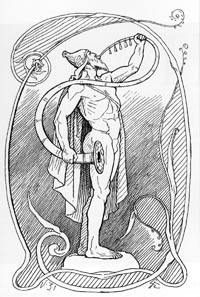Here, have a drink and relax.
Set at 22:08 on June 06, 2020

Websites
Quote: In the End We are all Chalk lines on the Pavement.
Greetings, I am Ha-Satan or HaSatan if you will but since I do enjoy a good party and not to mention a good orgy, I also go by Dionysus as well.
If the name sounds familar, that is because back in another age, there was a deity known as Dionysus. The god of wine and in my opinion, fun. Most would call it hedonism but I believe in less judging and more sex.
Repression is the ruination of your future but by embracing your wild side, you are providing an outlet for your desires and fears.
You can only truly know yourself when you embrace and explore the other parts of you. Don't be afraid of what lurks in your soul.
I do recommend that you make it a habit to at least once a month, go to a nice forest with some friends, build a huge campfire. Then add some music and when I say that, I of course mean "you" play the music. Using an instrument, not a radio or phone.
Whether you are good or bad at it is irrelevent as the participation and the release of emotions is what is important, not to mention that it would be a good time for everyone. The ritual requires completely giving in to it all and nothing does that better than riding your emotions as you play music for your friends or dance to it when someone else plays.
Then to complete the party, you drink some alcoholic ambrosia and revel in your freedom. Don't worry if you can't find your clothes the next day, chances are your friends have also lost their clothes.
There is no shame in releasing yourself emotionally or spiritually, it is important to be able to cleanse yourself and have carthasis but within reason of course, having followers who butcher each other or indulge in more negative impulses such as rape will kill the mood fast and it should not be tolerated.
Norse Legends
MIDGARD
Midgard (Old Norse Miðgarðr, Gothic midjungards, Old English middangeard, Old Saxon middilgard, Old High German mittilgart or mittangard, Proto-Germanic *meðjanagarðaz, “Middle Enclosure”) is one of the Nine Worlds of Norse mythology and an important concept in the pre-Christian worldview of all of the Germanic peoples. It’s the inhabited world, and roughly corresponds to the modern English word and concept of “civilization.” It’s the only one of the Nine Worlds that’s primarily located in the visible world; the others, while they may intersect with the visible world at various points, are first and foremost invisible locations.
ODIN

Odin (pronounced “OH-din”; Old Norse Óðinn, Old English and Old Saxon Woden, Old High German Wuotan, Wotan, or Wodan, Proto-Germanic *Woðanaz, “Master of Ecstasy”) is one of the most complex and enigmatic characters in Norse mythology, and perhaps in all of world literature. He’s the chief of the Aesir tribe of deities, yet he often ventures far from their kingdom, Asgard, on long, solitary wanderings throughout the cosmos on purely self-interested quests. He’s a relentless seeker after and giver of wisdom, but he has little regard for communal values such as justice, fairness, or respect for law and convention. He’s the divine patron of rulers, and also of outcasts. He’s a war-god, but also a poetry-god, and he has prominent transgender qualities that would bring unspeakable shame to any traditional Norse/Germanic warrior. He’s worshiped by those in search of prestige, honor, and nobility, yet he’s often cursed for being a fickle trickster. What kind of literary figure – let alone a god whose historical worship spanned much of a continent and several centuries – could possibly embody all of these qualities at once, with their apparently glaring contradictions?
In modern popular culture, Odin is often portrayed as being an eminently honorable ruler and battlefield commander (not to mention impossibly muscular), but to the ancient Norse, he was nothing of the sort. In contrast to more straightforwardly noble war gods such as Tyr or Thor, Odin incites otherwise peaceful people to strife with what, to modern tastes, is a downright sinister glee. His attitude is not far from Nietzsche’s dictum, “You say it is the good cause that hallows even war? I say unto you: it is the good war that hallows any cause.”
In keeping with his associations with sovereignty (see below), Odin doesn’t generally concern himself with average warriors, preferring instead to lavish his blessings only on those whom he deems to be worthy of them. Many of the greatest Germanic heroes have enjoyed Odin’s patronage, such as Starkaðr and the Volsung family. He maintains particularly close affiliations with the berserkers and other “warrior-shamans” whose fighting techniques and associated spiritual practices center around achieving a state of ecstatic unification with certain ferocious totem animals, usually wolves or bears, and, by extension, with Odin himself, the master of such beasts. Thus, as a war-god, Odin is principally concerned not with the reasons behind any given conflict or even its outcome, but rather with the raw, chaotic battle-frenzy (one of the primary manifestations of óðr) that permeates any such agonism.
THOR

Thor (Old Norse Þórr, Old English Đunor, Old High German Donar, Proto-Germanic *Þunraz, “Thunder”) is one of the most prominent figures in Norse mythology. He was a major god of all branches of the Germanic peoples before their conversion to Christianity, although he reached the height of his popularity among the Scandinavians of the late Viking Age.
Thor, the brawny thunder god, is the archetype of a loyal and honorable warrior, the ideal toward which the average human warrior aspired. He’s the indefatigable defender of the Aesir gods and their fortress, Asgard, from the encroachments of the giants, who are usually (although far from invariably) the enemies of the gods.
No one is better suited for this task than Thor. His courage and sense of duty are unshakeable, and his physical strength is virtually unmatched. He even owns an unnamed belt of strength (Old Norse megingjarðar) that makes his power doubly formidable when he wears the belt. His most famous possession, however, is his hammer, Mjöllnir (“Lightning”). Only rarely does he go anywhere without it. For the heathen Scandinavians, just as thunder was the embodiment of Thor, lightning was the embodiment of his hammer slaying giants as he rode across the sky in his goat-drawn chariot. (Of course, they didn’t believe he physically rode in a chariot drawn by goats – like everything else in Germanic mythology, this is a symbol used to express an invisible reality upon which the material world is perceived to be patterned.
LOKI

An anonymous painting of Loki from an Icelandic illuminated manuscript
Loki (pronounced “LOAK-ee;” Old Norse Loki, whose meaning/etymology is unknown) is the wily trickster god of Norse mythology.
While treated as a nominal member of the Aesir tribe of gods in the Eddas and sagas, Loki occupies a highly ambivalent and ultimately solitary position amongst the gods, giants, and the other classes of invisible beings that populate the traditional spirituality of the Norse and other Germanic peoples.
His familial relations attest to this. His father is the giant Fárbauti (“Cruel Striker”), and his mother, Laufey (possibly “Tree”), could be a goddess, a giantess, or something else entirely – the surviving sources are silent on this point. Loki is the father, by the giantess Angrboða (“Anguish-Boding”) of Hel, the goddess of the grave, Jormungand, the great serpent who slays Thor during Ragnarok, and Fenrir, the wolf who bites off one of the hands of Tyr and who kills Odin during Ragnarok – hardly a reputable brood, to say the least. As we’ll see below, Loki demonstrates a complete lack of concern for the well-being of his fellow gods, a trait which could be discerned, in vague outline, merely by considering his offspring.
Loki often runs afoul not only of societal expectations, but also of what we today might call “the laws of nature.” In addition to the progeny listed above, Loki is also the mother – yes, the mother – of Sleipnir, Odin’s shamanic horse, whom Loki gave birth to after shapeshifting into a mare and courting the stallion Svaðilfari, as is recounted in the tale of The Fortification of Asgard.
In the tales, Loki is portrayed as a scheming coward who cares only for shallow pleasures and self-preservation. He’s by turns playful, malicious, and helpful, but he’s always irreverent and nihilistic.
FRIGG

Frigg (pronounced “FRIG;” Old Norse Frigg, “Beloved”), sometimes Anglicized as “Frigga,” is the highest-ranking of the Aesir goddesses. She’s the wife of Odin, the chief of the gods, and the mother of Baldur.
Strangely for a goddess of her high position, the surviving primary sources on Norse mythology give only sparse and casual accounts of anything related to her personality, deeds, or other attributes. The specifics they do discuss, however, are not unique to Frigg, but are instead shared by both her and Freya, a goddess who belongs to both the Aesir and the Vanir tribes of deities. From these similarities, combined with the two goddesses’ mutual evolution from the earlier Germanic goddess Frija, we can see that Frigg and Freya were only nominally distinct figures by the late Viking Age, when our sources were recorded, and that these two figures, who had formerly been the same deity, were still practically the same personage in everything but name.
BALDUR

Baldur (pronounced “BALD-er;” Old Norse Baldr, Old English and Old High German Balder) is one of the Aesir gods. He’s the son of Odin and Frigg, the husband of the obscure goddess Nanna, and the father of the god Forseti.
He’s loved by all the gods, goddesses, and beings of a more physical nature. So handsome, gracious, and cheerful is he that he actually gives off light.
The meaning and etymology of his name are uncertain and have been the topic of intense scholarly debate. Numerous possibilities have been proposed, including a derivation from the Proto-Indo-European root *bhel- (“white”), Old Norse bál, “fire,” or a hypothesized word for “lord” common to various Germanic languages. The most straightforward – and probably correct – explanation, however, is that his name comes from the Old Norse word baldr, “bold.” Scholars have been reluctant to accept this explanation due to its implication of a warlike character for Baldur. But as we’ll see below, Baldur may not have been as innocent and passive as he’s portrayed to be in the late Old Norse literary source that provides the most extensive description of the god and the tales in which he features.
HEIMDALL

“Heimdall on the Rainbow Bridge” by Emil Doepler (1905)
Heimdall (pronounced “HAME-doll;” Old Norse Heimdallr, whose meaning/etymology is unknown) is one of the Aesir gods and the ever-vigilant guardian of the gods’ stronghold, Asgard.
His dwelling is called Himinbjörg (“Sky Cliffs,” connoting a high place ideal for a fortress), which sits at the top of Bifrost, the rainbow bridge that leads to Asgard. He requires less sleep than a bird. His eyesight is so keen that he can see for hundreds of miles by day or by night, and his hearing is so acute that he can hear grass growing on the ground and wool growing on sheep. Here he watches and listens, holding at the ready the horn Gjallarhorn (“Resounding Horn”), which he sounds when intruders are approaching.
During Ragnarok, the gods know that their doom is at hand when they hear the dire call of Gjallarhorn signaling the imminent arrival of the giants, who cross the rainbow bridge to storm Asgard and kill the gods. The disloyal Loki, the particular nemesis of the unwaveringly dutiful Heimdall, is with them. Loki and Heimdall slay each other as the world burns and sinks into the sea.
Taken together, certain verses in Old Norse poetry seem to indicate that Heimdall was once considered to be the father of humankind, and possibly to have established the hierarchical structure of Norse society as well.
FREYR

Freyr or Frey is one of the most important gods of Norse religion. The name is conjectured to derive from the Proto-Norse *frawjaz, "lord." Freyr was associated with sacral kingship, virility and prosperity, with sunshine and fair weather, and was pictured as a phallic fertility god; Freyr is said to "bestow peace and pleasure on mortals." Freyr, sometimes referred to as Yngvi-Freyr, was especially associated with Sweden and seen as an ancestor of the Swedish royal house.
In the Icelandic books the Poetic Edda and the Prose Edda, Freyr is presented as one of the Vanir, the son of the sea god Njörðr, as well as the twin brother of the goddess Freyja. The gods gave him Álfheimr, the realm of the Elves, as a teething present. He rides the shining dwarf-made boar Gullinbursti and possesses the ship Skíðblaðnir which always has a favorable breeze and can be folded together and carried in a pouch when it is not being used. He has the servants Skírnir, Byggvir and Beyla.
The most extensive surviving Freyr myth relates Freyr's falling in love with the female jötunn Gerðr. Eventually, she becomes his wife but first Freyr has to give away his magic sword which fights on its own "if wise be he who wields it." Although deprived of this weapon, Freyr defeats the jötunn Beli with an antler. However, lacking his sword, Freyr will be killed by the fire jötunn Surtr during the events of Ragnarök.
Like other Germanic deities, veneration of Freyr is revived in the modern period in Heathenry.
FREYA

In Norse mythology, Freyja (/ˈfreɪə/; Old Norse for "(the) Lady") is a goddess associated with love, sex, beauty, fertility, gold, seiðr, war, and death. Freyja is the owner of the necklace Brísingamen, rides a chariot pulled by two cats, keeps the boar Hildisvíni by her side, possesses a cloak of falcon feathers, and, by her husband Óðr, is the mother of two daughters, Hnoss and Gersemi. Along with her brother Freyr (Old Norse the "Lord"), her father Njörðr, and her mother (Njörðr's sister, unnamed in sources), she is a member of the Vanir. Stemming from Old Norse Freyja, modern forms of the name include Freya, Freija, Frejya, Freyia, Fröja, Frøya, Frøjya, Freia, Freja, Frua and Freiya.
Freyja rules over her heavenly afterlife field Fólkvangr and there receives half of those that die in battle, whereas the other half go to the god Odin's hall, Valhalla. Within Fólkvangr is her hall, Sessrúmnir. Freyja assists other deities by allowing them to use her feathered cloak, is invoked in matters of fertility and love, and is frequently sought after by powerful jötnar who wish to make her their wife. Freyja's husband, the god Óðr, is frequently absent. She cries tears of red gold for him, and searches for him under assumed names. Freyja has numerous names, including Gefn, Hörn, Mardöll, Sýr, Valfreyja, and Vanadís.
Freyja is attested in the Poetic Edda, compiled in the 13th century from earlier traditional sources; in the Prose Edda and Heimskringla, the two latter written by Snorri Sturluson in the 13th century; in several Sagas of Icelanders; in the short story Sörla þáttr; in the poetry of skalds; and into the modern age in Scandinavian folklore, as well as the name for Friday in many Germanic languages.
Scholars have theorized about whether Freyja and the goddess Frigg ultimately stem from a single goddess common among the Germanic peoples; about her connection to the valkyries, female battlefield choosers of the slain; and her relation to other goddesses and figures in Germanic mythology, including the thrice-burnt and thrice-reborn Gullveig/Heiðr, the goddesses Gefjon, Skaði, Þorgerðr Hölgabrúðr and Irpa, Menglöð, and the 1st century CE "Isis" of the Suebi. Freyja's name appears in numerous place names in Scandinavia, with a high concentration in southern Sweden. Various plants in Scandinavia once bore her name, but it was replaced with the name of the Virgin Mary during the process of Christianization. Rural Scandinavians continued to acknowledge Freyja as a supernatural figure into the 19th century, and Freyja has inspired various works of art.
| Member Since: | Jan 15, 2011 |
| Last Login: | Aug 03, 2021 |
| Times Viewed: | 29,377 |
| Times Rated: | 80 |
| Rating: | 9.878 |
Rate this profile
[ All Comments ]
RECENT JOURNAL POSTS
Whelp (1)

Changeling (71)

Arch Sire (194)
REAL VAMPIRES LOVE VAMPIRE RAVE
Vampire Rave is a member of
Page generated in 0.0776 seconds.














